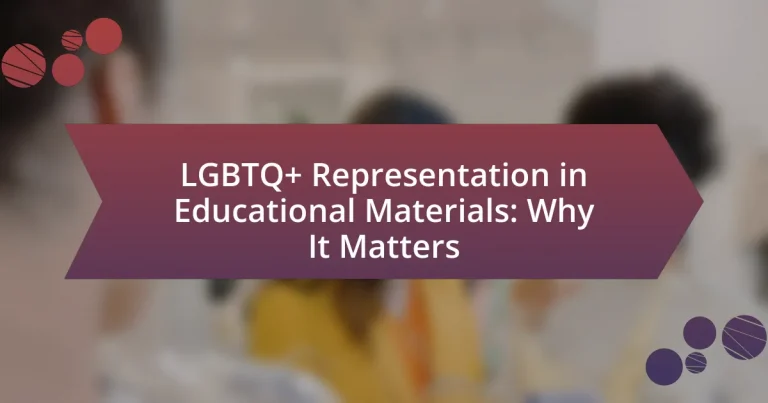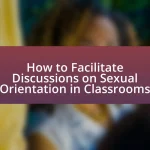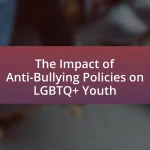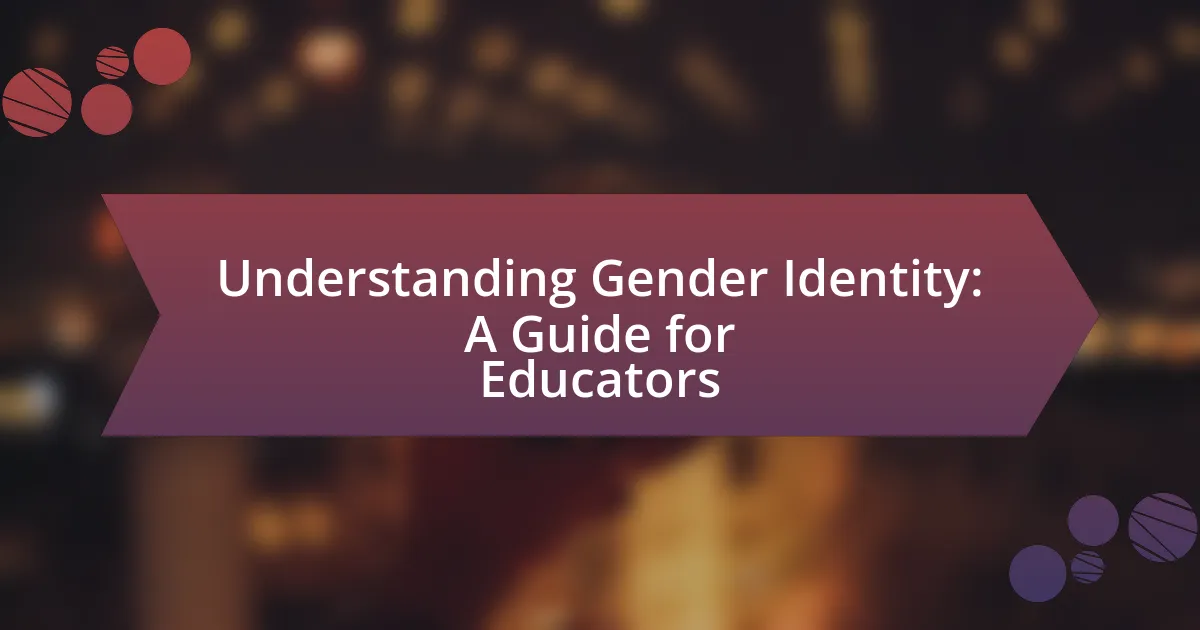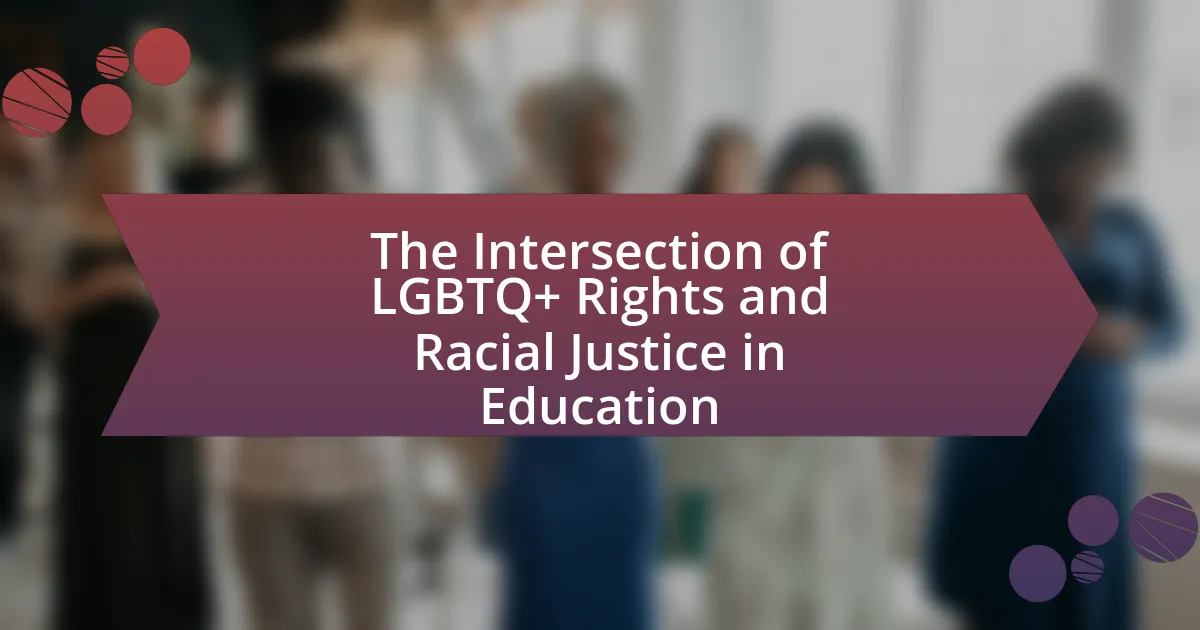LGBTQ+ representation in educational materials refers to the inclusion of LGBTQ+ individuals, histories, and issues within textbooks and curricula. This representation is crucial for creating inclusive learning environments, as it has been shown to improve the mental health and academic performance of LGBTQ+ students. The article explores the importance of LGBTQ+ representation, its impact on student well-being, current trends in educational materials, challenges faced in achieving adequate representation, and strategies for educators to effectively incorporate diverse perspectives. It emphasizes the positive effects of inclusive curricula on classroom dynamics and societal attitudes, while also addressing the long-term consequences of inadequate representation.

What is LGBTQ+ Representation in Educational Materials?
LGBTQ+ representation in educational materials refers to the inclusion and portrayal of LGBTQ+ individuals, histories, and issues within textbooks, curricula, and other educational resources. This representation is essential for fostering an inclusive learning environment, as studies show that inclusive educational materials can improve the mental health and academic performance of LGBTQ+ students. For instance, a 2019 study published in the Journal of Educational Psychology found that students exposed to LGBTQ+ inclusive curricula reported higher levels of school belonging and lower levels of bullying.
Why is LGBTQ+ representation important in education?
LGBTQ+ representation is important in education because it fosters an inclusive environment that validates diverse identities and experiences. This representation helps reduce stigma and discrimination, promoting mental well-being among LGBTQ+ students. Research indicates that inclusive curricula can lead to improved academic performance and higher self-esteem for LGBTQ+ youth. For instance, a study published in the Journal of Homosexuality found that students exposed to LGBTQ+ content reported feeling safer and more accepted in their school environments. Thus, integrating LGBTQ+ representation in educational materials is essential for creating equitable learning spaces.
How does representation impact LGBTQ+ students’ well-being?
Representation significantly enhances LGBTQ+ students’ well-being by fostering a sense of belonging and validation. When LGBTQ+ identities are accurately depicted in educational materials, students feel seen and understood, which can reduce feelings of isolation and anxiety. Research indicates that inclusive curricula lead to improved mental health outcomes; for instance, a study published in the Journal of Adolescent Health found that LGBTQ+ students who attended schools with inclusive policies reported lower rates of depression and higher self-esteem. This correlation underscores the importance of representation in promoting positive mental health and overall well-being among LGBTQ+ youth.
What role does representation play in fostering inclusivity?
Representation plays a crucial role in fostering inclusivity by ensuring that diverse identities and experiences are acknowledged and validated within educational materials. When LGBTQ+ individuals see themselves reflected in curricula, it promotes a sense of belonging and acceptance, which is essential for their emotional and social development. Studies indicate that inclusive representation can reduce bullying and discrimination, as it cultivates empathy and understanding among peers. For instance, research published in the Journal of Educational Psychology shows that students exposed to diverse narratives demonstrate increased acceptance of LGBTQ+ individuals, highlighting the transformative impact of representation in educational settings.
What are the current trends in LGBTQ+ representation in educational materials?
Current trends in LGBTQ+ representation in educational materials include increased visibility of diverse identities, integration of LGBTQ+ history and contributions into curricula, and the use of inclusive language and resources. Educational institutions are adopting policies that promote inclusivity, reflecting a broader societal shift towards acceptance and understanding of LGBTQ+ issues. For instance, a 2021 study by GLSEN found that 92% of LGBTQ+ students reported feeling safer in schools that included LGBTQ+ topics in their curriculum. This trend is supported by various educational organizations advocating for comprehensive sex education that includes LGBTQ+ perspectives, highlighting the importance of representation in fostering a supportive learning environment.
How have educational materials evolved to include LGBTQ+ perspectives?
Educational materials have evolved to include LGBTQ+ perspectives through the integration of diverse narratives, inclusive language, and representation in curricula. Historically, educational content often marginalized or omitted LGBTQ+ identities, but recent developments have led to the incorporation of LGBTQ+ themes in literature, social studies, and health education. For instance, the inclusion of books featuring LGBTQ+ characters and stories in school libraries has increased, with organizations like GLSEN advocating for such resources. Additionally, educational standards in various regions now emphasize the importance of teaching about LGBTQ+ history and rights, reflecting a broader societal recognition of diversity and inclusion. This evolution is supported by research indicating that inclusive educational materials positively impact the well-being and academic performance of LGBTQ+ students, fostering a more accepting and supportive learning environment.
What challenges still exist in achieving adequate representation?
Challenges in achieving adequate representation of LGBTQ+ individuals in educational materials include systemic bias, lack of inclusive curricula, and insufficient training for educators. Systemic bias often leads to the marginalization of LGBTQ+ topics, resulting in limited visibility and understanding in educational contexts. A study by GLSEN found that only 19% of LGBTQ+ students reported that their schools included LGBTQ+ topics in the curriculum, highlighting the lack of inclusive educational content. Additionally, many educators lack training on LGBTQ+ issues, which can perpetuate stereotypes and misinformation. This combination of factors contributes to an environment where LGBTQ+ representation remains inadequate, impacting the overall educational experience for students.

How does LGBTQ+ Representation Affect Learning Environments?
LGBTQ+ representation positively affects learning environments by fostering inclusivity and reducing discrimination. When educational materials include diverse sexual orientations and gender identities, students feel more validated and supported, which enhances their engagement and academic performance. Research indicates that inclusive curricula lead to lower rates of bullying and harassment; for instance, a study by GLSEN found that LGBTQ+ inclusive curricula significantly reduce victimization and improve school climate. Furthermore, representation helps all students develop empathy and understanding towards diverse communities, preparing them for a more inclusive society.
What benefits does inclusive representation provide to all students?
Inclusive representation provides all students with a sense of belonging and validation, which enhances their emotional well-being and academic performance. Research indicates that when students see themselves reflected in educational materials, it fosters a positive self-identity and reduces feelings of isolation. For instance, a study published in the Journal of Educational Psychology found that LGBTQ+ inclusive curricula improve engagement and academic outcomes for all students, not just those who identify as LGBTQ+. This inclusive approach also promotes empathy and understanding among peers, leading to a more supportive and cohesive learning environment.
How does it enhance empathy and understanding among peers?
LGBTQ+ representation in educational materials enhances empathy and understanding among peers by providing diverse perspectives that foster acceptance and reduce prejudice. When students encounter stories and characters that reflect LGBTQ+ experiences, they are more likely to develop compassion and recognize the shared humanity in others. Research indicates that inclusive curricula can lead to a 30% decrease in bullying and discrimination in schools, as students become more aware of and sensitive to the challenges faced by their LGBTQ+ peers. This exposure not only promotes a more inclusive environment but also encourages open dialogue, allowing students to engage with and learn from each other’s experiences.
What impact does it have on classroom dynamics?
LGBTQ+ representation in educational materials positively impacts classroom dynamics by fostering an inclusive environment that promotes acceptance and understanding among students. This representation helps reduce bullying and discrimination, as studies show that inclusive curricula can lead to a 30% decrease in instances of harassment based on sexual orientation or gender identity. Furthermore, when students see diverse identities reflected in their learning materials, it enhances their engagement and sense of belonging, which is crucial for their academic success.
How can educators effectively incorporate LGBTQ+ representation?
Educators can effectively incorporate LGBTQ+ representation by integrating diverse LGBTQ+ narratives and perspectives into the curriculum across various subjects. This approach not only fosters inclusivity but also reflects the realities of LGBTQ+ individuals, enhancing students’ understanding of social diversity. Research indicates that inclusive curricula can improve the academic performance and emotional well-being of LGBTQ+ students, as highlighted in the 2016 report by GLSEN, which found that schools with inclusive curricula had lower rates of bullying and higher levels of student engagement. By utilizing literature, history, and social studies that feature LGBTQ+ figures and events, educators can create a more equitable learning environment that validates all students’ identities.
What strategies can teachers use to include diverse perspectives?
Teachers can include diverse perspectives by integrating LGBTQ+ representation into their curriculum and classroom discussions. This can be achieved through selecting educational materials that feature LGBTQ+ authors, characters, and historical figures, thereby providing students with a broader understanding of different identities and experiences. Research indicates that inclusive curricula can enhance students’ empathy and reduce bullying, as highlighted in a study by GLSEN, which found that LGBTQ+ inclusive curricula positively impact school climate and student well-being. Additionally, teachers can create a safe space for open dialogue about diversity, encouraging students to share their own experiences and perspectives, which fosters an inclusive environment.
How can schools assess the effectiveness of their materials?
Schools can assess the effectiveness of their materials by evaluating student engagement, comprehension, and feedback related to the content. This can be achieved through surveys, focus groups, and performance assessments that specifically measure how well students understand and relate to the material, particularly in the context of LGBTQ+ representation. Research indicates that inclusive materials can enhance student empathy and understanding, as shown in studies like “The Impact of LGBTQ+ Inclusive Curriculum on Student Outcomes” by GLSEN, which found that students exposed to inclusive curricula reported feeling safer and more supported in their learning environments.

What are the Implications of Inadequate LGBTQ+ Representation?
Inadequate LGBTQ+ representation leads to significant negative implications, including perpetuation of stereotypes, increased discrimination, and mental health issues among LGBTQ+ individuals. Research indicates that when educational materials lack diverse representations, LGBTQ+ youth experience higher rates of bullying and mental health challenges, such as depression and anxiety. For instance, a study by GLSEN found that 59% of LGBTQ+ students felt unsafe at school due to their sexual orientation, highlighting the direct impact of insufficient representation on their well-being. Furthermore, inadequate representation can hinder societal acceptance and understanding, reinforcing harmful biases and limiting the visibility of LGBTQ+ contributions to culture and history.
What negative effects can arise from a lack of representation?
A lack of representation can lead to significant negative effects, including the perpetuation of stereotypes, increased mental health issues, and a sense of alienation among marginalized groups. When LGBTQ+ individuals are not represented in educational materials, it fosters an environment where their identities are invalidated, contributing to lower self-esteem and higher rates of depression and anxiety. Research indicates that LGBTQ+ youth are more likely to experience bullying and discrimination, which can be exacerbated by the absence of positive role models and inclusive narratives in educational contexts. For instance, a study by the Gay, Lesbian & Straight Education Network (GLSEN) found that schools with inclusive curricula reported lower levels of harassment and improved mental health outcomes for LGBTQ+ students.
How does it affect the mental health of LGBTQ+ students?
LGBTQ+ students experience significant mental health challenges due to a lack of representation and acceptance in educational environments. Research indicates that these students are at a higher risk for depression, anxiety, and suicidal ideation compared to their heterosexual peers. A study published in the Journal of Adolescent Health found that LGBTQ+ youth are more than twice as likely to experience mental health issues, with 40% reporting serious psychological distress. This distress is often exacerbated by bullying, discrimination, and a lack of supportive resources in schools. Therefore, the absence of positive LGBTQ+ representation in educational materials can lead to feelings of isolation and low self-worth, further impacting their mental health negatively.
What are the long-term consequences for societal attitudes?
Long-term consequences for societal attitudes regarding LGBTQ+ representation in educational materials include increased acceptance and reduced stigma towards LGBTQ+ individuals. Research indicates that inclusive educational content fosters understanding and empathy among students, leading to a more supportive environment. For instance, a study published in the Journal of Youth and Adolescence found that students exposed to LGBTQ+ topics in school reported higher levels of acceptance and lower levels of bullying towards their peers. This shift in attitudes can contribute to a more equitable society, where diversity is celebrated and discrimination is diminished.
What steps can be taken to improve LGBTQ+ representation in educational materials?
To improve LGBTQ+ representation in educational materials, educational institutions should incorporate diverse LGBTQ+ perspectives and histories into curricula. This can be achieved by reviewing and revising existing materials to include contributions from LGBTQ+ authors and scholars, ensuring that their experiences and narratives are represented. Research indicates that inclusive curricula positively impact students’ understanding and acceptance of diversity; for instance, a study published in the Journal of Homosexuality found that LGBTQ+ inclusive education reduces bullying and improves mental health outcomes for LGBTQ+ youth. Additionally, training educators on LGBTQ+ issues and inclusive teaching practices can further enhance representation and create a supportive learning environment.
How can stakeholders advocate for better representation?
Stakeholders can advocate for better representation by actively engaging in policy-making processes and promoting inclusive educational materials that reflect LGBTQ+ identities. This can be achieved through collaboration with educators, curriculum developers, and advocacy organizations to ensure that LGBTQ+ perspectives are integrated into lesson plans and resources. Research indicates that inclusive curricula improve the educational experience for all students, fostering a more accepting and understanding environment. For instance, a study by GLSEN found that LGBTQ-inclusive curricula lead to a 30% decrease in bullying and harassment in schools, demonstrating the positive impact of representation on student well-being.
What resources are available for educators seeking to improve representation?
Educators seeking to improve representation can access a variety of resources, including organizations, curricula, and professional development programs. Notable organizations such as GLSEN (Gay, Lesbian & Straight Education Network) provide lesson plans and training focused on LGBTQ+ inclusivity. Additionally, the Human Rights Campaign offers educational resources that promote understanding and acceptance of LGBTQ+ identities. Research indicates that inclusive curricula positively impact student well-being and academic performance, highlighting the importance of these resources in fostering an equitable learning environment.
What best practices should educators follow for effective LGBTQ+ representation?
Educators should incorporate diverse LGBTQ+ perspectives in their curriculum to ensure effective representation. This can be achieved by including LGBTQ+ authors, historical figures, and contemporary issues in lesson plans, which fosters an inclusive environment. Research indicates that inclusive curricula positively impact students’ understanding and acceptance of diverse identities, as shown in a study by GLSEN, which found that LGBTQ+ inclusive curricula lead to safer school environments and improved mental health outcomes for LGBTQ+ students. Additionally, educators should engage in professional development focused on LGBTQ+ issues to enhance their understanding and teaching practices, further supporting an inclusive educational atmosphere.
